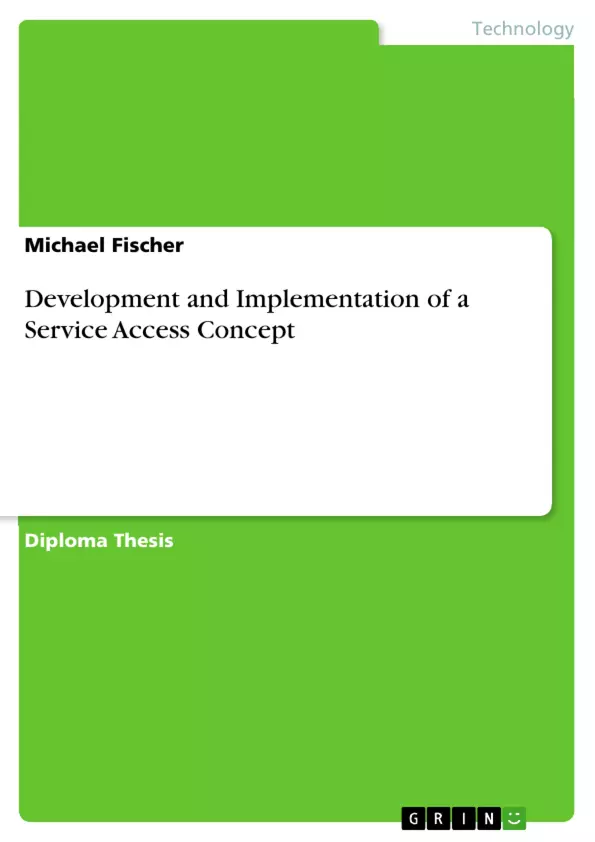Successive to a preceding study about Service Discovery, this thesis covers the topics Service Description and Service Access. Starting with an analysis and comparison of existing technologies, a new protocol for the service access was developed and an operating
environment, capable of accessing services of any type was programmed. Thereby emphasis is placed on high scalability, extensibility, modularity and comprehensive documentation, to provide easy association with existing or future works. The first part deals with the various versions of Service Descriptions, followed by a description of the service access methods and concluding with a comprising comparison. All technologies or protocols qualified for Service Discovery and Access discovered
during this diploma thesis are discussed. The main part comprises the software implementation which was written in Java, including
a comprehensive documentation containing, among others, the protocol specification, software architecture, an user guide and proposals for advancements.
Inhaltsverzeichnis (Table of Contents)
- Introduction
- Topic
- Content
- How to Read This Paper
- General
- Introducing Reflections
- A Possible Scenario
- Ad Hoc Networking
- State of the Art
- Future Situation
- Reflections About Service Discovery, Description and Access
- The Problem of automated Interaction
- Use Cases
- Service Discovery
- Service Access
- URLS/URIS/URNS, Namespaces
- URI
- URL
- URN
- Comparison URN - URL
- Overview of the Different Techniques
- SLPV2
- UPnP
- Jini
- Salutation
- JetSend
- Inferno
- SDP (Bluetooth)
- Introducing Reflections
- Service Description
- SLPv2
- The Service-URL, Accessing SLP
- Abstract Service Types
- Definition of Attributes
- Mandatory Attributes
- Registration and Standardization of New Service Types
- Explanatory Example
- UPnP
- Device Description
- Service Description
- Template Design Process
- Example
- Jini
- Service Architecture
- Remarks
- Description
- Salutation
- Architecture
- Service Description/Capability Exchange
- Functional Unit Description
- SLPv2
Zielsetzung und Themenschwerpunkte (Objectives and Key Themes)
This diploma thesis aims to explore and develop a comprehensive service access concept, building upon previous research on service discovery. The work focuses on developing a new protocol for dynamic service access and implementing a functional environment capable of accessing diverse services. The emphasis is on achieving high scalability, extensibility, modularity, and comprehensive documentation to ensure easy integration with existing or future projects. Key themes explored in this thesis include:- Service Description: Analyzing and comparing existing service description technologies and protocols.
- Service Access: Developing a new protocol for dynamic service access.
- Software Implementation: Implementing a functional environment in Java for accessing services.
- Scalability, Extensibility, and Modularity: Designing the service access concept with focus on these aspects.
- Comprehensive Documentation: Providing detailed documentation for the protocol, software architecture, and future development.
Zusammenfassung der Kapitel (Chapter Summaries)
- Introduction: This chapter provides an overview of the topic, content, and structure of the thesis, outlining the purpose and scope of the work.
- General: This chapter discusses the background and context of service discovery, description, and access. It explores the evolution of technologies, potential scenarios, and the challenges of automated interaction.
- Service Description: This chapter delves into the various methods of describing services, examining existing protocols like SLPv2, UPnP, Jini, and Salutation. The chapter presents the advantages, limitations, and key features of each technology.
Schlüsselwörter (Keywords)
This diploma thesis revolves around the central themes of service discovery, service description, and service access. It delves into the development and implementation of a dynamic service access concept, exploring various existing technologies like SLPv2, UPnP, and Jini. Key concepts addressed include scalability, extensibility, modularity, comprehensive documentation, and Java software implementation. The work aims to contribute to the understanding and advancement of service-oriented architectures, particularly in the context of dynamically accessible services.- Quote paper
- Michael Fischer (Author), 2001, Development and Implementation of a Service Access Concept, Munich, GRIN Verlag, https://www.grin.com/document/185645



